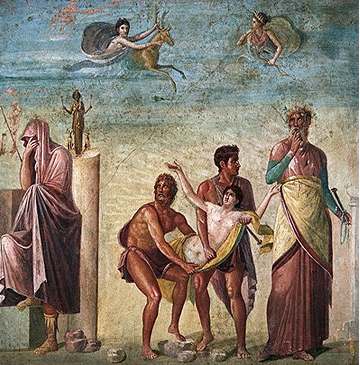The sacrifice of the Argive princess, besides its general human interest, is a striking testimony to the fact, that even among the most cultivated peoples of the ancient world, human sacrifice prevailed at an early period of their history. There are certain principles in the human heart which, at a certain stage of civilisation, seem to make such a practice a sort of moral necessity. That this practice existed even in the most polished age of Athens in a modified form is certain---vide the dictionaries, in voce Φαρμακός. The idea of the substitution of the stag by Diana, in order to save the virgin's life, and the conveyance of the destined victim of a bloody devotion to the barbarous service of a grim idol in the Crimea, was an afterthought---one of those beautiful lies with which the legendary lore of old Hellas is replete.[2]
1. Fresco found in Pompei, based on the 4th-century B.C. painting by Timanthus.
2. Blackie, John Stuart. Lays and legends of ancient Greece.
William Blackwood and Sons: Edinburgh. 1880.
3. Tiepolo, Giovanni Battista. The Sacrifice of Iphigenia. Fresco. 1757.
_
2. Blackie, John Stuart. Lays and legends of ancient Greece.
William Blackwood and Sons: Edinburgh. 1880.
3. Tiepolo, Giovanni Battista. The Sacrifice of Iphigenia. Fresco. 1757.
_



No comments:
Post a Comment